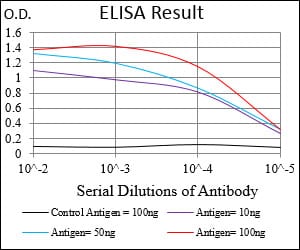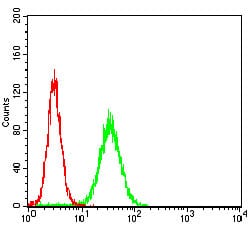

| WB | 咨询技术 | Human,Mouse,Rat |
| IF | 咨询技术 | Human,Mouse,Rat |
| IHC | 咨询技术 | Human,Mouse,Rat |
| ICC | 技术咨询 | Human,Mouse,Rat |
| FCM | 1/200 - 1/400 | Human,Mouse,Rat |
| Elisa | 1/10000 | Human,Mouse,Rat |
| Aliases | SEMA3A;HH16; SemD; COLL1; SEMA1; SEMAD; SEMAL; coll-1; Hsema-I; SEMAIII; Hsema-III |
| Entrez GeneID | 10371 |
| clone | 1G6F9 |
| WB Predicted band size | 89kDa |
| Host/Isotype | Mouse IgG1 |
| Antibody Type | Primary antibody |
| Storage | Store at 4°C short term. Aliquot and store at -20°C long term. Avoid freeze/thaw cycles. |
| Species Reactivity | Human |
| Immunogen | Synthesized peptide of human SEMAPHORIN-3A (AA: 359-372). |
| Formulation | Purified antibody in PBS with 0.05% sodium azide. |
+ +
以下是关于SEMAPHORIN-3A(SEMA3A)抗体的3篇代表性文献,按研究领域分类简要概括:
---
1. **文献名称**:*Semaphorin 3A is a guidance cue for sensory nerve regeneration in adult skin*
**作者**:Tonge DA 等(2017)
**摘要**:研究利用SEMA3A抗体阻断实验,证明SEMA3A通过抑制神经元轴突导向蛋白(Neuropilin-1)通路,调控皮肤损伤后感觉神经的再生过程。
2. **文献名称**:*Semaphorin 3A suppresses tumor growth and metastasis in melanoma*
**作者**:Vadasz Z 等(2020)
**摘要**:通过SEMA3A抗体中和实验,发现SEMA3A在黑色素瘤中通过抑制血管生成和肿瘤细胞迁移发挥抑癌作用,提示其作为潜在治疗靶点。
3. **文献名称**:*Semaphorin 3A regulates osteoblast differentiation in mice*
**作者**:Fukuda T 等(2018)
**摘要**:研究使用SEMA3A抗体检测骨组织中SEMA3A表达,发现其通过Wnt/β-catenin信号通路抑制成骨细胞分化,影响骨代谢平衡。
---
如需具体DOI或期刊信息,可进一步补充关键词或研究场景。
Semaphorin-3A (SEMA3A), a secreted glycoprotein belonging to the class 3 semaphorin family, functions as a key axon guidance cue during neural development. It binds to neuropilin-1/plexin receptor complexes, mediating repulsive signaling that regulates neuronal migration, axon pathfinding, and synapse formation. Beyond the nervous system, SEMA3A participates in diverse physiological and pathological processes, including immune regulation, angiogenesis, tumor progression, and bone homeostasis. Its role in cancer is context-dependent, acting as either a tumor suppressor by inhibiting angiogenesis and metastasis or promoting invasiveness in certain malignancies.
Antibodies targeting SEMA3A are essential tools for investigating its expression patterns, signaling mechanisms, and therapeutic potential. These antibodies enable detection of SEMA3A in tissues and fluids via techniques like Western blot, immunohistochemistry, and ELISA. In research, they help elucidate SEMA3A's involvement in neurodegenerative diseases, autoimmune disorders (e.g., rheumatoid arthritis), and cancer biology. Therapeutic applications are under exploration, including blocking SEMA3A to enhance nerve regeneration or modulating its activity in cancer immunotherapy. Commercial SEMA3A antibodies are typically raised in hosts like rabbits or mice, with validation across multiple applications to ensure specificity for reliable experimental outcomes.
×